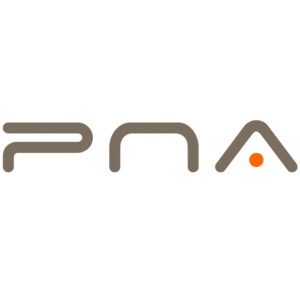There are two common types of 400G transceiver packages: OSFP and QSFP-DD. OSFP-packaged optical transceivers have good thermal performance and can be scaled up to 800G, but they have a larger size. The optical transceivers in QSFP-DD packaging are simpler and more compatible. For 400G optical transceivers, both OSFP and QSFP-DD use the 8x50G/PAM4 electrical signal for the host interface, which means they both employ PAM4 modulation. This article will introduce the PAM4 modulation scheme and its application in 400G transceivers.
What is PAM4 in Optical Communications?
PAM4 (Pulse Amplitude Modulation 4-Level) is a crucial and fundamental technology in the field of optical communications. Before understanding PAM4, it is necessary to be familiar with another basic signal modulation technique: NRZ (Non-Return-to-Zero), also known as PAM2 (2-level). NRZ is a digital logic signal that uses high and low signal levels to represent transmitted information. For unipolar non-return-to-zero codes, “1” and “0” correspond to positive level and zero level, or negative level and zero level. For bipolar non-zero codes, “1” and “0” correspond to positive level and equivalent negative level.
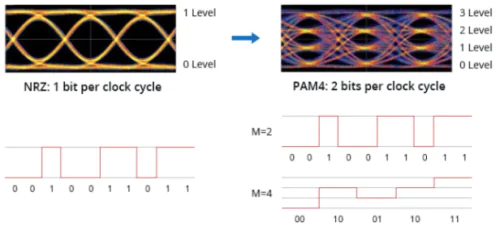

With the continuous increase in bandwidth demand, we need to find ways to increase the amount of logical information transmitted per unit of time. As a more advanced modulation technology, PAM4 has emerged.
- It uses four different signal levels for signal transmission.
- It can represent logical information from 1 bit per symbol period in NRZ to 2 bits.
- For example, a 25G EML chip can be transformed into a single-channel 50G PAM4 optical transceiverthrough PAM4 modulation.
Why does 400G Ethernet adopt PAM4 Technology?
Initially, when the IEEE Association was developing new-generation 200G/400G interface standards such as 400GBASE-SR16, PAM4 technology was not considered. Instead, NRZ technology was used to achieve 400G transmission rates through a 16x25Gbps parallel channel. However, this solution required a large amount of fiber, making it economically infeasible. Additionally, the timing margin, transmission link loss, and size of the transceiver chips did not meet the requirements of 400G Ethernet.
Therefore, when developing the 802.3bs standard, the IEEE Association proposed using PAM4 instead of NRZ. After in-depth research and testing of the characteristics and parameters of PAM4 signals, this proposal was ultimately approved. Subsequently, the 400GBASE-LR8/400GBASE-FR8 interface standards based on PAM4 technology were established, becoming the first 400G interface standards. The interface standards utilize 8x50Gbps PAM4 technology to achieve 400G transmission. It no longer requires 16x25G channels like NRZ to achieve 400G transmission. This approach saves fiber costs and reduces link loss.
Application of PAM4 in 400G Transceivers
PAM4 is the primary modulation scheme for 400G QSFP-DD optical transceivers and comes in two types: multimode and single-mode. For 400G transceivers based on PAM4 modulation, the electrical interface utilizes 8x50G PAM4 modulation, while the optical interface supports two modulation schemes: 8x50G PAM4 and 4x100G PAM4.
Multimode 400G Transceivers
Common multimode 400G optical transceivers include the SR8 and SR4.2 interfaces, both of which employ 8x50G PAM4 modulation.
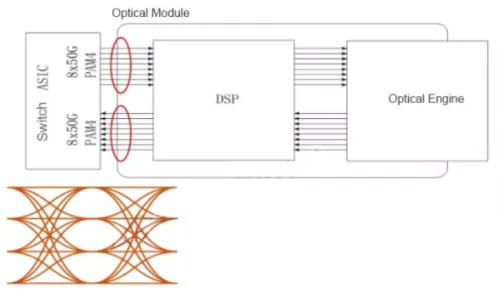

- 400G SR8: “SR” denotes the use of multimode fiber for transmitting over a distance of 100 meters, and “8” indicates the presence of eight optical channels. When each optical channel operates at 50G PAM4, a total of 16 fibers is required (8 TX and 8 Rx). 400G SR8 optical transceivers can be connected using either MPO-16 or MPO-24 connectors, accommodating 8 pairs of fibers.
- 400G SR4.2: “SR” refers to the use of multimode fiber for transmitting over a distance of 100 meters, “4” indicates four optical channels, and “2” signifies that each optical channel has two wavelengths. The 400G SR4.2 transceiverutilizes an MPO-12 connector, with each optical channel using 2x50G PAM4, requiring a total of 8 fibers. The wavelengths are bidirectional and multiplexed. The main advantage of SR4.2 is the ability to continue using existing fiber resources.
| Module Type | Transmission Distance | Fiber Type | Optical Interface | Fiber Core | Wavelength | Modulation |
| 400G SR8 | 100m | Parallel Multi-mode | MPO-16(APC) | 16 | 850nm | 50G PAM4 |
| 400G SR4.2 | 100m | Parallel Multi-mode | MPO-12(APC) | 8 | 850nm/910nm | 50G PAM4 |
Single-mode 400G Transceivers
Single-mode 400G optical transceivers can be divided into two categories. One type utilizes 8x50G PAM4 modulation on the optical interface, while the other type employs 4x100G PAM4 modulation. Both methods use DSP for CDR (without analog CDR) or a combination of Gearbox and CDR. The difference lies in the signal transmission rate on the line side and the number of lasers used.
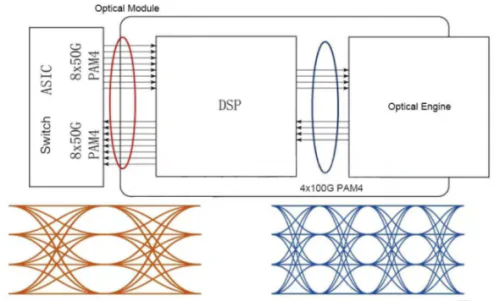

Single-mode 400G transceivers based on 8x50G PAM4
Under this modulation scheme, there are three common types of 400G optical transceivers: FR8, LR8, and 2xFR4.
400G FR8 and 400G LR8 were the first available single-mode interfaces for 400G. “8” indicates the use of eight wavelengths, with each wavelength employing 50G PAM4 modulation. “FR” denotes transmission over 2 km, while “LR” signifies transmission over 10 km. By multiplexing the eight wavelengths into a single fiber, FR8 and LR8 optical transceivers utilize duplex LC optical interfaces.
2xFR4 400G optical transceivers utilize eight lasers but are divided into two groups of four wavelengths each (according to the 200G FR4 standard). Each group is multiplexed into a fiber, and the optical transceiver provides 2x200G signals on two CS connectors.
| Module Type | Transmission Distance | Fiber Type | Optical Interface | Fiber Core | Wavelength | Modulation |
| 400G 2×FR4 | 2km | SMF | 2×CS | 4 | 4(CWDM4) | 50G PAM4 |
| 400G FR8 | 2km | SMF | LC | 2 | 8(LWDM) | 50G PAM4 |
| 400G LR8 | 10km | SMF | LC | 2 | 8(LWDM) | 50G PAM4 |
However, there are trade-offs when using the 8x50G solution. On one hand, they provide improved link budgets in certain cases, but on the other hand, the total laser cost per transceiver is higher, the optical packaging is more complex, resulting in lower yields and higher production costs. In comparison, the 4x100G transceivers have lower power consumption and simpler heat management capabilities. Therefore, the 4x100G solution is expected to be more popular.
Single-mode 400G Transceivers based on 4x100G PAM4
The 4x100G optical transceivers are the focus of the current market. They utilize four channels of 100G PAM4 on the line side. Here, we can categorize these optical transceivers as “multi-fiber” and “dual-fiber.” The key components of these optical transceivers are DSPs with Gearbox functionality, including DR4, FR4, and LR4.
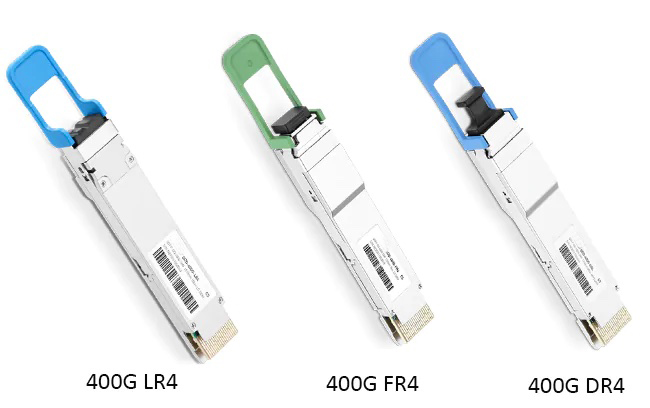

400G DR4: In 400G DR4 optical transceivers, the DSP converts 8x50G PAM4 electrical signals into 4x100G PAM4 and then transmits them to the optical engine. At the same time, the DSP functions as a CDR, and each channel operates at a wavelength of 1310nm. Each channel requires a single fiber, so a total of 8 fibers are needed.
400G FR4 and LR4: The basic functionality of the DSP in FR4 and LR4 optical transceivers is the same as in DR4. However, now four wavelengths (CWDM4) are used instead of four 1310nm signals, and a multiplexer is added to combine these CWDM signals. As a result, FR4/LR4 requires only 2 fibers (TX+Rx) and utilizes duplex LC optical interfaces.
| Module Type | Transmission Distance | Fiber Type | Optical Interface | Fiber Core | Wavelength | Modulation |
| 400G DR4 | 500m | SMF | MPO-12(APC) | 8 | 1(1310nm) | 100G PAM4 |
| 400G FR4 | 2km | SMF | LC | 2 | 4(CWDM4) | 100G PAM4 |
| 400G LR4 | 10km | SMF | LC | 2 | 4(CWDM4) | 100G PAM4 |
In conclusion, with the emergence of big data and cloud computing, the rapid growth of traffic has forced signal modulation technology to evolve in a more complex direction. As the most efficient modulation technology currently available, PAM4 has become an inevitable trend in the development of 400G high-speed optical transceivers.
In the future, considering cost, the approach of achieving 400G transmission through 4-channel optical signals may become mainstream. Additionally, the electrical interfaces of optical transceivers may gradually transition to the form of 4x100G PAM4, eliminating the need for Gearbox chips to save power consumption and costs.
As a leading provider of comprehensive optical networking solutions, PNA Fiber can continuously offer innovative, efficient, and reliable 400G high-speed optical transceivers and their overall solutions, significantly enhancing customer business acceleration capabilities at low cost and with outstanding performance.



